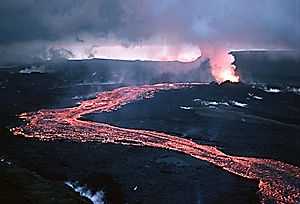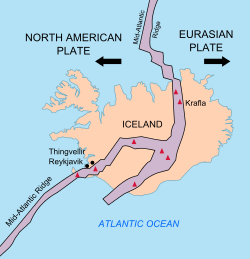Iceland hotspot



The Iceland hotspot is a hotspot which is partly responsible for the high volcanic activity which has formed the island of Iceland.
Description
Iceland is one of the most active volcanic regions in the world, with eruptions occurring on average roughly every three years (in the 20th century there were 39 volcanic eruptions on and around Iceland). About a third of the basaltic lavas erupted in recorded history have been produced by Icelandic eruptions. Notable eruptions have included that of Eldgjá, a fissure of Katla, in 934 (the world's largest basaltic eruption ever witnessed), Laki in 1783 (the world's second largest), and several eruptions beneath ice caps, which have generated devastating glacial bursts, most recently in 2010 after the eruption of Eyjafjallajökull.
Iceland's location astride the Mid-Atlantic Ridge, where the Eurasian and North American Plates are moving apart, is partly responsible for this intense volcanic activity, but an additional cause is necessary to explain why Iceland is a substantial island while the rest of the ridge mostly consists of seamounts, with peaks below sea level.
As well as being a region of higher temperature than the surrounding mantle, it is also believed to have a higher concentration of water. The presence of water in magma reduces the melting temperature, and this may also play a role in enhancing Icelandic volcanism.
Theories of causation
There is an ongoing discussion whether the hotspot is caused by a deep mantle plume or originates at a much shallower depth.[1]
Some geologists have questioned whether the Iceland hotspot has the same origin as other hotspots such as the Hawaii hotspot. While the Hawaiian island chain and the Emperor Seamounts show a clear time-progressive volcanic track caused by the movement of the Pacific Plate over the Hawaiian hotspot, no such track can be seen at Iceland.
It is proposed that the line Grímsvötn volcano to Surtsey shows the movement of the Eurasian Plate and the line Grímsvötn volcano to Snæfellsnes volcanic belt shows the movement of the North American Plate.[2]
Mantle plume theory
It is believed that a mantle plume underlies Iceland, of which the hotspot is thought to be the surface expression. This enhances the volcanism already caused by plate separation, both at the centre of the island and at the Reykjanes ridge to the southwest of Iceland's main volcanic zone. The plume is believed to be quite narrow, perhaps 100 km across, and extends down to at least 400–650 km beneath the Earth's surface, and possibly down to the core-mantle boundary.
Studies suggest that the hotspot is only 50-100 K hotter than its surroundings, which may not be a great enough difference to drive a buoyant plume.
It is suggested that the lack of a time-progressive track is because the plume may have been located beneath the thick Greenland craton for a significant time.
See also
- Geography of Iceland
- Glaciers of Iceland
- Glacial lake outburst flood
- Iceland plume
- List of lakes of Iceland
- List of islands of Iceland
- List of volcanoes in Iceland
- Plate tectonics
- List of rivers of Iceland
- Volcanology of Iceland
- Waterfalls of Iceland
References
Notes
Bibliography
- Allen, R. M.; Nolet, G.; Morgan, W. J. et al. (1999). "The thin hot plume beneath Iceland". Geophysical Journal International 137 (1): 51–63. Bibcode:1999GeoJI.137...51A. doi:10.1046/j.1365-246x.1999.00753.x.
- Foulger, Gillian R. (February 8, 2005). "Iceland & the North Atlantic Igneous Province". Retrieved November 19, 2014.
- Foulger, G. R.; Anderson, D. L. (2005). "A cool model for the Iceland hotspot". Journal of Volcanology and Geothermal Research 141 (1–2): 1–22. Bibcode:2005JVGR..141....1F. doi:10.1016/j.jvolgeores.2004.10.007.
- Morgan, W. Jason; Morgan, Jason Phipps (2009). "Plate velocities in hotspot reference frame: electronic supplement" (PDF). In Foulger, Gillian R.; Jurdy, Donna M. Plates, Plumes, and Planetary Processes (P4). Retrieved November 19, 2014.
- Nichols, A. R. L.; Carroll, M. R.; Höskuldsson, Á. (2002). "Is the Iceland hot spot also wet? Evidence from the water contents of undegassed submarine and subglacial pillow basalts". Earth and Planetary Science Letters 202 (1): 77–87. Bibcode:2002E&PSL.202...77N. doi:10.1016/S0012-821X(02)00758-6.